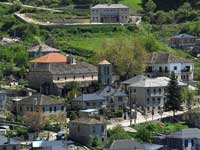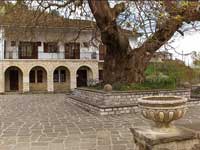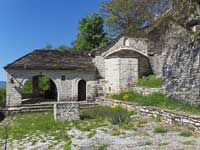

Administrative Region : Epirus
Regional unit : Ioannina
Skamneli (Σκαμνέλλι) Ioannina
Skamneli is a village in the Zagori region (Epirus region), 54 km north of Ioannina. It is built in the fringes of mountain Tymfi (Mt Tymphe), at a height of 1160 m.
Name
The name "Skamneli" is of uncertain origin. It may derive from the word "sycaminea" (Greek: συκαμινέα, the sycamore of the Bible - the fig-mulberry tree). There are several villages and toponyms in Greece with the name Sycaminea or Sykamia. It is more likely, however, that the name is derived from the Greek "skamnos" (σκαμνός), "skamnon" (σκάμνον) or "skamni" (σκαμνί) (Latin: scamnum, scannellum that means "seat" or "footstool") perhaps because the village itself seems like a seat and has an amphitheatric view. Skamneli is flanked by the steep cliff of Rhadio (Greek: Ραδιό < ῥάδιον) meaning easy or accessible, (if so, a euphemism) on its western side and the hill of Prophetes Elias on the eastern side and looks over the valley of Selio (Σελιό), perhaps from Greek: σέλιον or σήλιον, archaic form of Greek: ἥλιον meaning "of the sun" or sunny, as this area remains out of the shadow of Rhadio for the entire day. At the bottom of the valley of Selio passes the Skamneliotic stream (Skamneliotiko rema).


The village is not mentioned in the Turkish records of 1564. There seemed to be in the area several other small villages that slowly coalesced with Skamneli in the 17th century. These were Catuna or Catuni, Agios Georgios, Prophetes Elias, Gardiki, Trepesi, Kotsanades, Palaiochori (Koziakos-Katsikochori) and Nouka. Nouka was a small settlement of Vlachs at Gyftokampos.
History
Skamneli Palaiokastro
The region of the village was inhabited since prehistoric times, as there have been found ancient, so-called pelasgian fortifications, known by the locals also as the Palaiokastro.[1] They were visited by Nicholas Hammond in 1930 and in 1939, prior to his publication of his book Epirus.[2] Prof Daskaris of the University of Ioannina dated these to the 8th century BC.
Moreover, remains of a 4th to 3rd C BC circular tower, a rectangular tower, a gate and two smaller doorways have been identified near the entrance of the village in the vicinity of the Monastery of Agia Paraskevi. In the Ottoman period, Skamneli belonged to the Commons of the Zagorisians (Greek: Κοινόν Ζαγορισίων) formed after a treaty with Sinan-Pasha in 1431. Ιτ enjoyed along with the other villages a joint autonomy from Ottoman rule. The autonomy guaranteed non-interference from the Turkish administration. Zagorisians had their affairs entrusted to a Council of Elders called Demogerontia (Δημογεροντία), headed by a president or governor called Vekylis (Βεκύλης). They were allowed to maintain an armed security force of Spachedes (σπαχήδες). The Commons of the Zagorisians was reformalised by a treaty signed in 1670, under which Zagori enjoyed considerable privileges called Surutia, which were only rescinded by the Sultan in 1868. In the later part of the 17th century, the inhabitants of several hamlets began to gather together in Skamneli. The reason for this was probably raids from bandits. One major such raid is recorded in the books of the Monastery of Agia Paraskevi, according to Frangoulis[3] dated to 1688, by one named Ali Chogmeno at the head of 166 men. He gathered the women and children in the church of Agioi Apostoloi and began a looting of the village. Armatoloi arrived from Doliani, another village in Zagori, under their captain Douvlis and dispersed the bandits after killing Ali Chogmeno. At the time Skamneli had about 1000 inhabitants and was surrounded by several hamlets with an additional 800 inhabitants. Plagued by raids from mainly Albanian and Turkish bandits, the inhabitants of the countryside and hamlets around Skamneli began to emigrate to other villages of Zagori (Tsepelovo, Vradeto and Negades) and also to Northern Epirus (modern Albania), in Karitsa, Molista, Sopiki and especially to Moschopolis (Voskopolis), where a neighborhood became called Skamnelia (Σκαμνελιά), Skamneliki (Σκαμνελίκι) or Skamnelicili.
In the second half of the 18th century, Skamneli is believed to have had a population of about 950, according to Frangoulis, based on two surviving village records, but other estimates are of up to 800 families for the entire region. Vikos doctors were active in the area at that time. Looms were worked by the women of Skamneli, producing garments, blankets and woolen fabrics. The foundations of the manors of Skamneli date from this period and were built by masons from Konitsa. During a tour of Mt Tymphe, Ali Pasha was caught by a storm and spent a night in Skamneli at the manor of the Saitzis family, reputed to have caused the admiration of the tyrant.

In 1820, after the rebellion of Ali Pasha, a Turkish force of 1500 under Ismael Pasha arrived in Zagori, part of the total army of 20,000 sent against Ali Pasha. Alexis Noutsos from Kapesovo, a member of the Filiki Eteria who had intermarried with the Saitzis family and owned a house in Skamneli, was in command of the force opposing Ismael Pasha. However, the Sultan's armies prevailed. Ismael Pasha removed most privileges other than the right to appoint a local governor (Vekylis), whose powers however became nominal. Ismael Pasha introduced very heavy taxation, amounting to 250 silver coins per person and additional taxation in kind. The bands of the Spachedes, left without income, resorted also to extortion. Albanian and local bandits began looting raids once again. This is the time when prominent Greeks everywhere have become members of the Filiki Eteria and are preparing the uprising against the Turks in 1821. The Skamneliot Georgios Papazoglou proposes to Georgios Gennadios in Constantinople (Istanbul) the idea of the establishment of a Greek university at the Monastery of Rogovou, outside nearby Tsepelovo. The idea had also been proposed by Neophytos Doukas, at the time possibly living in Tsepelovo. The plan never materialzed because of the limited success of the Greek revolution, that left Epirus under Ottoman rule. Georgios' brother Kostas Papazoglou, another member of the Filiki Eteria, leaves for Missolonghi, where he will lead and finance a cavalry company during the Greek War of Independence.
Several Skamneliots enlisted in the Sacred Band of Alexander Ypsilantis in the opening phase of the Greek War of Independence and fought in Drăgăşani.[3] However, Zagori failed to gain its liberation and was not included in the Kingdom of Greece formed in 1833. In 1837, during a raid by bandits under a man called Vryazis, the bandits find the veteran of the Greek War of Independence Costas Papazoglou in his house in Skamneli and kill him, looting his house among others. In 1868 Zagori lost its last privileges and Skamneli entered a period of further impoverishment and decline. At that time, so-called "gypsies" and pastoral Sarakatsani Vlachs lived here in addition to its traditional inhabitants. The "gypsies", believed by the locals to have been brought to Europe by the Turks from Asia, were involved in the making of tools and utensilis and other metalwork, as well as musical instruments. The pastoral Vlachs of the period managed the livestock of the wealthier families. Both groups became gradually assimilated into the village society. After the battle of Bizani during the first Balkan War (1912), the inhabitants of Skamneli and Tsepelovo rose up. A Turkish unit subsequently entered the village and set fire to all the houses whose occupants were absent. The public records of the village also perished.[3] In 1940 villagers from Skamneli helped in turning back the Italian army that had entered Epirus. Later Napoleon Zervas established his partizans in the area. The village became almost deserted during the Greek Civil War (1946-9) and more of the older stone houses fell to ruin in the subsequent period.
Buildings
Skamneli,village centre
Skamneli,St.Paraskevi
While some of the grander houses, such as those of the Noutsos and Saitzis families, became ruins, other houses were repaired by the few remaining impoverished inhabitants. Repairs were not always sympathetic to the traditional forms. However, there are some old manors still in existence, built in the traditional style of Zagori, notably that of the Gennadios family, near the village square and those of Cyparrisos, Frangoulis and Theodosiou. A unique characteristic of these manors were murals with floral themes covering the interior and they were also characterised by their unique carved wooden ceilings. While the older ceilings are now mostly gone, a very fine example of modern work in the old Scamneliot style can be seen in the hotel "To Rhadio" (το Ραδιό), along the main road, near the church of the Apostles.
The church of Agioi Apostoloi was built in 1793 next to the village square by a benefaction from two Skamneliots living in Moldovlachia, Demetrios and Christodoulos Saitzes. Ιτ has beautiful wooden panelling and is of considerable historical significance as a representative of the style of the period. Young Skamneliotes used to study in Ioannina or in Italy and in Constantinople during the Ottoman period and would emigrate for work to Constantinople, Asia Minor, Russia, the Danubian principalities of Moldova, Wallachia and Bessarabia, known collectively as Moldovlachia, in Romania and also to Egypt. More recently there has been emigration also to the U.S.A..[4] There used to be two large monasteries near the entrance of Skamneli, that of Agios Nikolaos housed monks while that of Agia Paraskevi originally housed nuns. The Monastery of Agios Nikolaos dates from 1683. Parts of the monk's quarters, the church and a picturesque roofed well still remain.
Skamneli village square
The Monastery of Agia Paraskevi dates from the 12-13th centuries, as some of the oldest murals suggest, during the period of the Despotate of Epirus. It was founded as a nunnery with 60 nuns. On the record of its last commissioner, it became a "Stavropegiac" monastery in 1453, after the Fall of Constantinople, and has remained under the direct jurisdiction of the Patriarchate of Constantinople. It was refounded in 1697 as a male monastery. Some of the frescoes were painted in 1717 and 1773 by painters from nearby Kapesovo and from Chionades. The exterior fresco mainly around the theme of the Final Judgement was apparently made by a hagiographer from nearby Koukouli. The frail frescoes were restored in 1933 and 1984. The monastery became ruinous and only the central church remains out of the original foundation. Another old church, that of the Panagia (Church of the Yperagia Theotokos or the Dormition of the Theotokos) has suffered from disrepair and, although still standing, has been closed to the public.
Folklore
The village celebrates the Feast of Agia Paraskevi, on the 26th of July, with a local festival.
Near the village lies Gyftokampos, a place of an annual meeting of the Greek-speaking Epirotan Vlachs Sarakatsani on the first weekend of August. It is also an exhibition ground every year, from May till October, with huts and other representations of the traditional life of the Sarakatsani.
A custom surviving until recently in Skamneli was a divination referred to as the "amileto nero" (unbespoken water). It involved an offering of water and grain by adolescent girls, relating to an ancient Demetriac festival of the month of Gamelion. Reputedly, the springwater mourmoured an omen, usually relating to the girl's future marital life.
According to Odysseas Frangoulis, St Cosmas (Kosmas Aitolos or Cosmas of Aetolia) preached in Skamneli outside the monastery of Agios Nikolaos. He prophesied "when you see here many horses gathered, the Romioi are coming". When the village was burnt in 1912 by the retreating Turks, they had left their horses outside the monastery.
Wedding customs
Weddings in former times were governed by tradition.[3] Following engagement, and an exchange of rings, it was customary for a young Skamneliot to follow a more experienced elder abroad for work or study. They paid irregular visits to Skamneli, following the local maxim "do not visit your home often, so that you are filled with constant longing". Friends of the bride would gather nightly to knit the dowry. The duty for the final preparations and the feast were for the groom. On the Thursday before the wedding, boys and girls carried the dowry to the groom's house. On the eve of the wedding, bread was baked and children were sent to the houses of the groom and the bride to summon them. The bride, upon leaving her family home would throw over a pitcher, spilling its contents of water and grains of wheat to the ground, so that not all good fortune left her parents' home. The bride would set out on a white horse, wearing a knitted vest over a gilded dress held together by a golden waistband decorated with florins. In more recent times the dress was white on the day of the wedding but the young bride was dressed in a black silken dress on the second day. Arriving at the groom's house with her companions (fylachtades), she would have to overcome gracefully some obstacle, the nature of which was kept secret. Much tutoring was made in advance, so that she might deal with any problem and gain respect and admiration. After the wedding, always on a Sunday, there was a feast with music by Epirotan musicians. The family would lead the dance and the newlyweds would join last. It was the responsibility of the leader of the ceremonies, called Vlamis (the best man), to fulfill any request of the guests regarding food. Feasts would often take place in the open ground of the Selio south of the village or in the fountain of Goura above the village. Wedding celebrations would last for three days. In the second day, the married couple would go to a water fountain, often a place of trysts for young lovers. The bride would let her water pitcher fall and break. She would then sing a song:
"If you go to the fountain for water,
I will be hiding there;
I will break your pitcher,
So that you return to your mother empty handed."
"My mother, I lost my footing
and I broke my pitcher."
"It was not a loss of footing,
It was a man's embracing."
Before leaving the fountain, the bride would cast coins in it. The dancing and merry-making would continue until the third day and would end with words from the bride's parents to the effect "we brought you a bride, we brightened your house". These wedding customs have become a thing of the past as only a few inhabitants remain year-round in Skamneli.
Prominent Skamneliots
Adam Gorgidas, a professor of Medicine at the University of Budapest, member of the Philike Etairia (Filiki Eteria) translated in 1849 the Encheiridion of Practical Pathology of D.P. Frank from Latin into Greek.
Skamneli also is the birthplace of the national benefactor Aggeliki Papazoglou (ca. 1810-1891).[5] Among else, she provided the funds for the building of a library for the University of Athens and built a school for girls in Ioannina, the Papazogleios.
Georgios Sinas, Director of the Bank of Austria for 25 years, was a national benefactor, responsible for the building of the National Astronomical Observatory in Athens and was among the first trustees of the Bank of Greece after Greek independence. He was born in Moschopolis of Northern Epirus and was of Skamneliot descent.
Simon Sinas, baron, son of Georgios Sinas, was a Greek Consul in Vienna. He funded the building of the National Academy in Athens, considered by some as the most beautiful neoclassical building in the world.
Sources
www.timfi.gov.gr (in Greek)
References
^ A.Kathareios (Inspector of the 1st educational region of Epirus) Report of Inspection of Zagorohoria in 1913
^ Nicholas G.L. Hammond Epirus, 1967
^ a b c d Frangoulis, Odysseas T., Το Σκαμνέλι. Συμβολή στην ιστορία του, ήθη - έθιμα - παραδόσεις (Skamneli, a Contribution to its History: Cultural Practices, Customs, and Traditions), published by the Association of Skamneliots in Zagori, Ioannina 1988
^ A.Kathareios (Inspector of the 1st educational region of Epirus) Report of Inspection of Zagorochoria in 1913
^ Papazogloy www.giannena-e.gr
| Municipal unit Tymfi |
|---|
| Community Vradeto |
| Vradeto (Βραδέτο, το) |
| Community Vrysochori |
| Vrysochori (Βρυσοχώρι, το) |
| Community Iliochori |
| Iliochori (Ηλιοχώρι, το) |
| Community Kapesovo |
| Kapesovo (Καπέσοβο, το) |
| Community Kipoi |
| Kipoi (Κήποι, οι) |
| Community Koukkouli |
| Koukkouli (Κουκκούλι, το) |
| Community Laista |
| Laista (Λαΐστα, η) |
| Community Leptokarya Zagoriou |
| Leptokarya (Λεπτοκαρυά, η) |
| Community Negades |
| Negades (Νεγάδες, οι) |
| Community Skamnelli |
| Skamneli (Σκαμνέλλι, το) |
| Community Tsepelovo |
| Τσεπέλοβο, το |
| Community Fragkades |
| Fragkades (Φραγκάδες, οι) |
Greece :
A - B - C - D - E - F - G - H - I - J - K - L - M -
N - O - P - Q - R - S - T - U - V - W - X - Y - Z
Retrieved from "http://en.wikipedia.org/"
All text is available under the terms of the GNU Free Documentation License
| Ancient Greece
Science, Technology , Medicine , Warfare, , Biographies , Life , Cities/Places/Maps , Arts , Literature , Philosophy ,Olympics, Mythology , History , Images Medieval Greece / Byzantine Empire Science, Technology, Arts, , Warfare , Literature, Biographies, Icons, History Modern Greece Cities, Islands, Regions, Fauna/Flora ,Biographies , History , Warfare, Science/Technology, Literature, Music , Arts , Film/Actors , Sport , Fashion --- |

